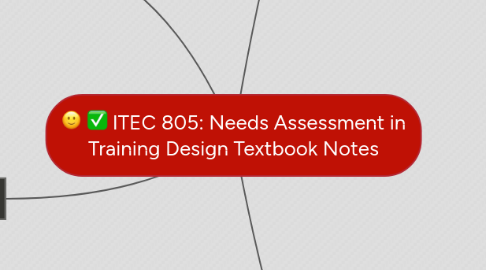
1. Target Groups & Levels of Need
1.1. Level 1: Service Receivers
1.2. Level 2: Service Providers
1.3. Level 3: Resources/Systems
2. Phase 2: Needs Assessment
2.1. Focus on Subsystem(s)
2.2. Gather Data
2.2.1. 1. Archival
2.2.2. 2. Communication Processes
2.2.2.1. Interactive
2.2.2.2. Non-Interactive
2.2.3. 3. Analytical
2.3. Priortize Level 1 Needs
2.4. Perform Casual Analyses
2.5. Synthezie all Data for each Need
2.5.1. Identify Factors Within & Outside System
2.6. Aggregate & Analyze
2.6.1. Paired-Weighting Procedure (PWP)
2.7. Contexts
2.7.1. 1.Planning
2.7.1.1. Document Needs, Develop Programs, Strategies
2.7.1.2. Short-Term
2.7.1.3. Long-Term
2.7.1.4. What is Known?
2.7.1.4.1. 1. Characteristics
2.7.1.4.2. 2. Design (similar characteristics)
2.7.1.4.3. 3. Types (patterns/similar characteristics)
2.7.1.4.4. 4. Failure Analysis (similar characteristics
2.7.2. 2. Evaluation
2.7.2.1. To determine success in meeting goals
2.7.2.2. (But, Summative Evaluation: Continue or Drop Program & Formative Evaluation: Improve Program - all of which can lead to NA's)
2.7.3. 3. Cyclical NA (Iterative)
2.7.3.1. Conduct NA every 1-2 years
2.7.3.1.1. Then, changes expected before NA for next time
2.7.4. 4. MIS (ongoing NA)
2.7.4.1. Database for qualitative & quantitative & formative & summative info
2.7.5. 5. Collaborative (Interagency) NA
2.7.5.1. 2 or more agencies
2.7.5.1.1. Ex: City & School District
3. 3. Postassessment
3.1. Solidify Priorities
3.1.1. Set in Categories
3.1.2. Set in Critical Needs
3.1.3. Level 2 Needs
3.1.3.1. Derived from Job Analysis (ITEC 801)
3.1.4. For Trainees
3.1.4.1. R-C-D
3.1.4.1.1. Relevance (task/skill)
3.1.4.1.2. Competence (for performance)
3.1.4.1.3. Desire (to undergo training)
3.1.5. Risk Assessment
3.1.5.1. If need isn't met, what are consequences?
3.2. Create Solutions
3.2.1. Based on Criteria
3.2.1.1. Feasibility
3.2.1.2. Acceptability
3.2.1.3. Effect on the Causes
3.2.2. Consider Alternative Solutions
3.2.3. Evaluate Alternatives
3.2.3.1. Force Field Analysis (FFA)
3.2.3.1.1. Driving (supporting) Forces
3.2.3.1.2. Refraining Forces
3.2.4. Select Solutions
3.2.5. Press F1 to see all key shortcuts
3.3. Action Plan
3.3.1. To be approved
3.3.1.1. Solutions
3.3.1.2. Timelines
3.3.1.3. Budget
3.3.1.4. Human/Physical Resources
3.3.1.5. Rationale
3.4. Evaluate Completed NA
3.4.1. For Future NA's
3.4.2. For Quality
3.4.2.1. Personal Todo List
3.4.2.2. Vacation Planning
3.4.2.3. Meeting Minutes
3.4.2.4. Project Plan
3.4.2.5. more...
3.5. Reports & Briefs (keep in mind audience to involve)
3.5.1. NAC
3.5.2. Needers
3.5.3. Powerful People/Approvers/Financers
4. Phase 1: Pre-Assessment
4.1. Analyze Goals
4.1.1. Identify Issues
4.1.1.1. Determine if Training is Needed or Another Less Costly Solution
4.2. Identify Preliminary Needs
4.2.1. Review any History of NA's
4.2.1.1. Amplify/Clarify Existing Sources of Info via Surveys
4.3. Determine Scope
4.4. Data-Gathering
4.4.1. Consider Contexts of NA Activity
4.4.2. Use Findings
4.4.3. Select Instruments
4.5. Purpose of Results
4.5.1. NAcessor discuss with NAC (Planners)
4.5.2. Memorandum of Agreement
